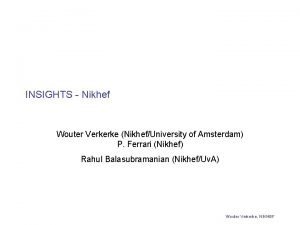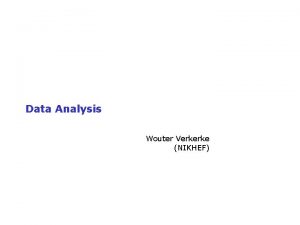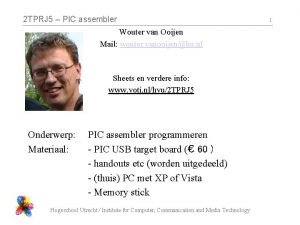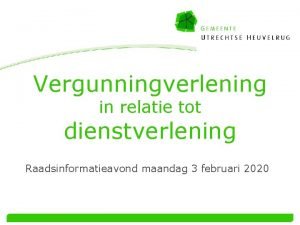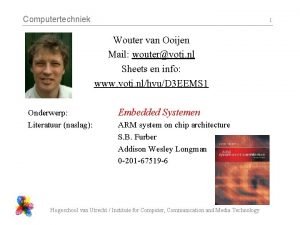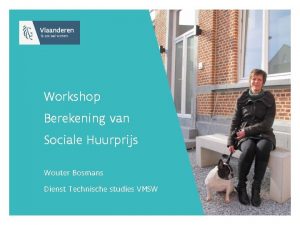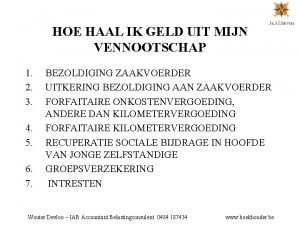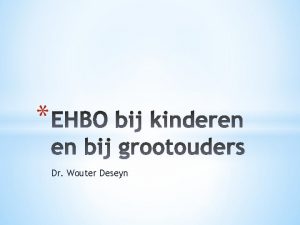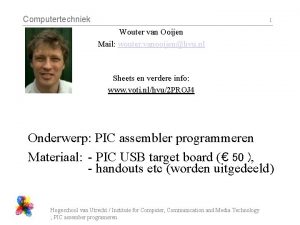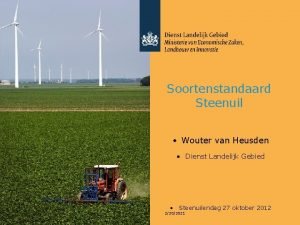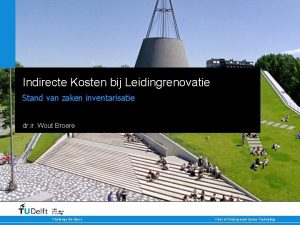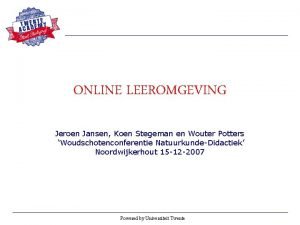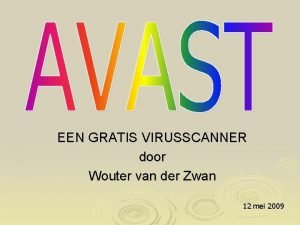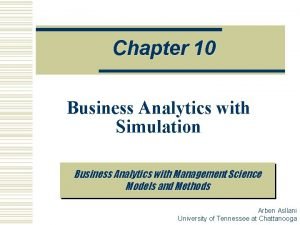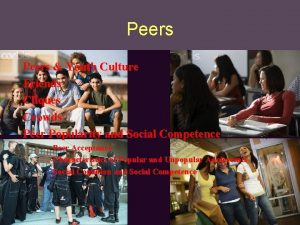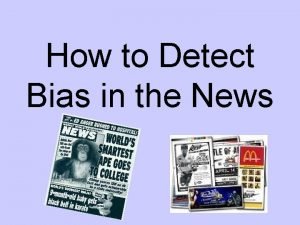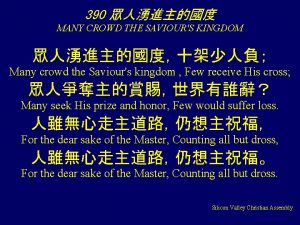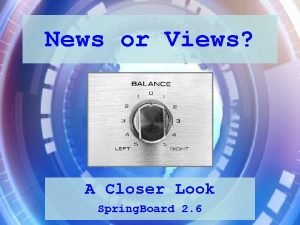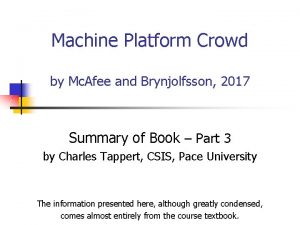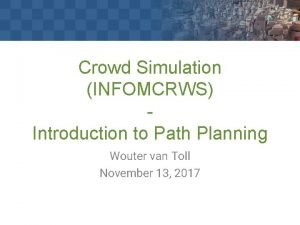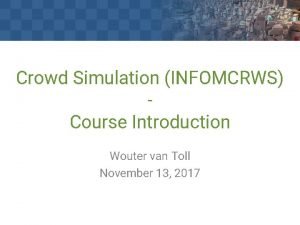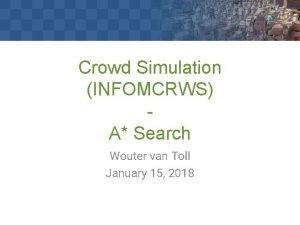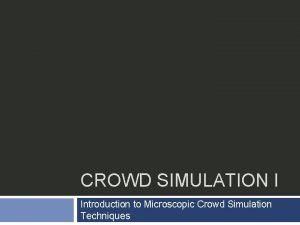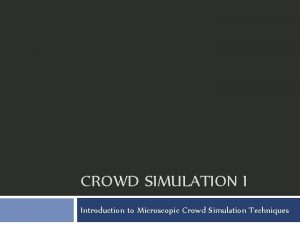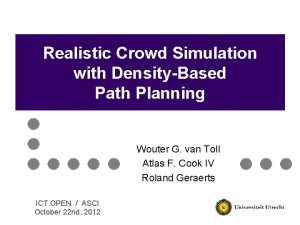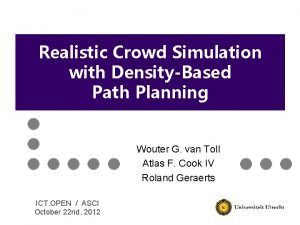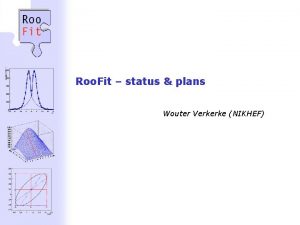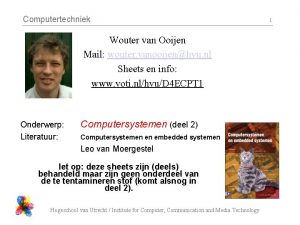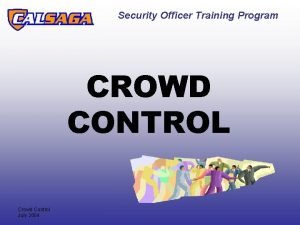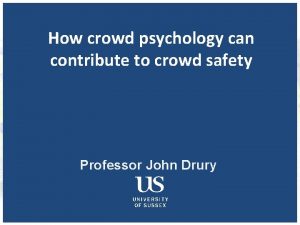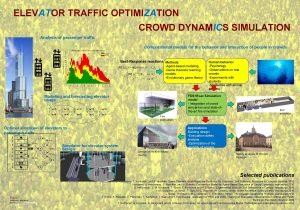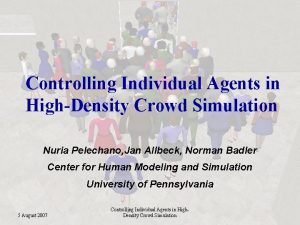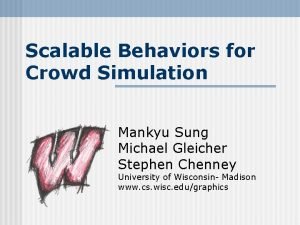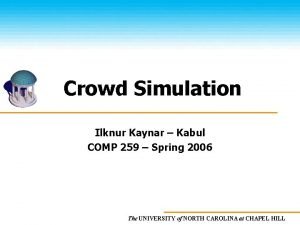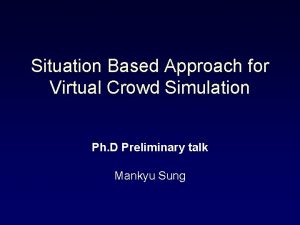Crowd Simulation INFOMCRWS Introduction to Crowd Simulation Wouter

































- Slides: 33

Crowd Simulation (INFOMCRWS) Introduction to Crowd Simulation Wouter van Toll November 15, 2017

Contents • Recap – Path planning and navigation meshes • Overview of crowd simulation research – Multi-level crowd simulation – Other topics – Open problems May 25, 2021 INFOMCRWS: Introduction to Crowd Simulation 2

RECAP Path planning and navigation meshes May 25, 2021 INFOMCRWS: Introduction to Crowd Simulation 3

Crowd simulation Virtual environment (3 D) Crowd simulation (often 2 D) Fancy visualization (3 D) May 25, 2021 INFOMCRWS: Introduction to Crowd Simulation 4

Crowd simulation • Many applications (entertainment + serious) Planet Coaster (Frontier) Grand Depart 2015 (Movares), using our software • Large crowds Many queries – We want real-time performance May 25, 2021 INFOMCRWS: Introduction to Crowd Simulation 5

Region-based path planning • Navigation mesh = Regions + (Dual) Graph – Many spatial subdivisions exist – Grids are easiest, but imperfect • Coverage, connectivity, storage Trapezoidal map May 25, 2021 Triangulation INFOMCRWS: Introduction to Crowd Simulation Grid 6

Region-based path planning Query Shortest path in the graph Sequence of regions Indicative route (via funnel algorithm ) Simulation loop Q: Shortest path? May 25, 2021 INFOMCRWS: Introduction to Crowd Simulation 7

Path planning in games • Trend – – Graphs, grids Navigation meshes Manual Automatic Static Dynamic Increasingly large crowds • Typical errors – – Incorrect graphs Unnatural paths Poor response to dynamic updates Insufficient local methods / collision avoidance May 25, 2021 INFOMCRWS: Introduction to Crowd Simulation 8

TOWARDS AN OVERVIEW OF CROWD SIMULATION METHODS A Generic Categorization of Research Areas May 25, 2021 INFOMCRWS: Introduction to Crowd Simulation 9

Overview (1/6) Path planning Algorithms: A*, Dijkstra, . . . May 25, 2021 Data structures: Navigation meshes, grids, . . . INFOMCRWS: Introduction to Crowd Simulation 10

Path planning – Examples • Shortest path • Other criteria Funnel algorithm: Shortest path from a corridor Density-based (van Toll et al. , 2012) May 25, 2021 Stealth-based (Schager & Geraerts, 2010) INFOMCRWS: Introduction to Crowd Simulation 11

Overview (2/6) Path planning Algorithms: A*, Dijkstra, . . . Data structures: Navigation meshes, grids, . . . Local movement (“steering”) Collision avoidance May 25, 2021 Groups, coherence, social rules, . . . INFOMCRWS: Introduction to Crowd Simulation 12

Local movement: Examples Social forces (Helbing & Molnár, 1995) Flocking (Reynolds, 1987) Vision-based collision avoidance (Moussaïd et al, 2010) Velocity obstacles (van den Berg et al. , 2009+) May 25, 2021 INFOMCRWS: Introduction to Crowd Simulation 13

Local movement: More examples Streams (van Goethem et al. , 2015) Social groups (Kremyzas et al. , 2016) Coherent groups (Kamphuis & Overmars, 2004) May 25, 2021 INFOMCRWS: Introduction to Crowd Simulation 14

Overview (3/6) Path planning Algorithms: A*, Dijkstra, . . . Data structures: Indicative route Navigation meshes, grids, . . . Path following Local movement Collision avoidance May 25, 2021 Groups, coherence, social rules, . . . INFOMCRWS: Introduction to Crowd Simulation 15

Intermezzo: Weighted regions • What if the environment is more complex than “walkable + obstacles”? – Polygonal areas with (personal) costs • Find minimum-cost path? – Unsolvable in the Algebraic Computation Model over the Rational Numbers – Approximation algorithms • Path following May 25, 2021 MIRAN (Jaklin et al. , 2013) INFOMCRWS: Introduction to Crowd Simulation 16

Overview (4/6) Path planning Visualization Animation Rendering Path following Local movement Simulation loop May 25, 2021 INFOMCRWS: Introduction to Crowd Simulation 17

Overview (5/6) High-level planning Path planning Modelling Logic: BDI, rules, memory, . . . Path following Local movement Fixed steps of 0. 1 s Simulation loop As fast as possible Animation loop Visualization May 25, 2021 INFOMCRWS: Introduction to Crowd Simulation 18

Overview (6/6) High-level planning Path following Local movement Visualization May 25, 2021 INFOMCRWS: Introduction to Crowd Simulation 19

Multi-level planning • Advantages? Path planning Path following Local movement – Split a big problem into simpler components – Mix and match various algorithms – Different behaviour per character • Disadvantages? – Choices in one level affect behavior in lower levels • When to reconsider these choices? (e. g. re-planning) May 25, 2021 INFOMCRWS: Introduction to Crowd Simulation 20

Alternative: Potential field • Continuous field of forces – – Goal attracts, obstacles repel Follow the direction of steepest descent Common implementation: Grid In case of moving characters (obstacles): update potential field each frame Robot motion planning (Latombe, 1991) May 25, 2021 INFOMCRWS: Introduction to Crowd Simulation 21

Alternative: Potential field • Advantages – Unifies global and local movement – Re-usable for similar characters Good for high-density crowds Treuille et al. , 2006 • Disadvantages – Grid implementation – Different potential field for each goal / each character type – Local minima Narain et al. , 2009 • Can be avoided, but (even) more expensive May 25, 2021 INFOMCRWS: Introduction to Crowd Simulation 22

OTHER TOPICS A mixed bag May 25, 2021 INFOMCRWS: Introduction to Crowd Simulation 23

Coordination and re-planning Linear programming (Karamouzas et al. , 2013) Dynamic updates + visibility-based re-planning (van Toll et al. , 2015) May 25, 2021 INFOMCRWS: Introduction to Crowd Simulation 24

Moving through a dense crowd • Find a path that uses gaps between characters – Global becomes local? Torso crowds (Stüvel et al. , 2015) May 25, 2021 INFOMCRWS: Introduction to Crowd Simulation 25

Multi-threading • In a simulation step, many characters do “the same thing” at the same time – Allows parallel programming – GPU: thousands of tasks at the same time • Advantage: performance • Disadvantage (GPU): – What about rendering? May 25, 2021 INFOMCRWS: Introduction to Crowd Simulation 26

Evaluation • How to compare different methods? 1. Generic definitions 2. Objective quality metrics 3. Scenarios that cover the problem space 4. Conclusions(? ) Steer. Bench (Singh et al. , 2009) A comparative study of navigation meshes (van Toll et al. , 2016) May 25, 2021 INFOMCRWS: Introduction to Crowd Simulation 27

Evaluation • How to prove that a simulation is close to reality? • Compare to reality!. . . but how? – Individual trajectories – Global trends – Density/speed relation Lerner et al. , 2009 • When is a conclusion general enough? May 25, 2021 INFOMCRWS: Introduction to Crowd Simulation 28

CLOSING COMMENTS */ May 25, 2021 INFOMCRWS: Introduction to Crowd Simulation 29

Summary High-level planning Coordination, re-planning Path planning or: Potential fields Path following Local movement Visualization May 25, 2021 Multi-threading / GPU Evaluation INFOMCRWS: Introduction to Crowd Simulation 30

Remaining challenges • Navigation: see previous lecture • Problems within this paradigm – Reconsider global paths due to local hazards – High-level coordination • Long-term goals – Reliable validation • Human-like simulation for any scenario? – Huge crowds (≥ 1 M) in real-time – Crowd prediction during a real-time event May 25, 2021 INFOMCRWS: Introduction to Crowd Simulation 31

Next time • Explanation of our crowd simulation software • Tutorial to get started with Assignment 2 May 25, 2021 INFOMCRWS: Introduction to Crowd Simulation 32

Preparation for next time • If you haven’t done so yet. . . – Choose a non-taken paper (1 -20) to present – Form teams for Assignments 1 and 2 • Prepare for the tutorial – Bring a (Windows) laptop! – Install Unity – Read up on basic Unity usage May 25, 2021 See website INFOMCRWS: Introduction to Crowd Simulation 33
 Wouter slegers
Wouter slegers Langrangian
Langrangian Wouter verkerke
Wouter verkerke Wouter van ooijen
Wouter van ooijen Wouter bouwman relatie
Wouter bouwman relatie Maarten driessen
Maarten driessen Wouter van ooijen
Wouter van ooijen Wouter hulsbergen
Wouter hulsbergen Wouter bosmans
Wouter bosmans Wouter verkerke
Wouter verkerke Bestuurskunde en publiek management
Bestuurskunde en publiek management Wouter devloo
Wouter devloo Wouter arrazola de oñate
Wouter arrazola de oñate Wouter deseyn
Wouter deseyn Wouter van ooijen
Wouter van ooijen Wouter van heusden
Wouter van heusden Wouter akema
Wouter akema Wouter de cock
Wouter de cock Wouter stegeman
Wouter stegeman Wouter van der zwan
Wouter van der zwan Introduction to modeling and simulation
Introduction to modeling and simulation Pengertian pemodelan dan simulasi
Pengertian pemodelan dan simulasi Introduction to business analytics using simulation
Introduction to business analytics using simulation Glittering generalities propaganda technique
Glittering generalities propaganda technique The chief determinant of popularity in high school is:
The chief determinant of popularity in high school is: Bias through selection and omission examples
Bias through selection and omission examples Bias through statistics and crowd counts examples
Bias through statistics and crowd counts examples Examples of conventional crowds
Examples of conventional crowds Conventional crowd
Conventional crowd Many crowd the savior's kingdom
Many crowd the savior's kingdom Crip gangs
Crip gangs Bias through statistics and crowd counts examples
Bias through statistics and crowd counts examples Machine platform crowd summary
Machine platform crowd summary Strategy crowd
Strategy crowd

